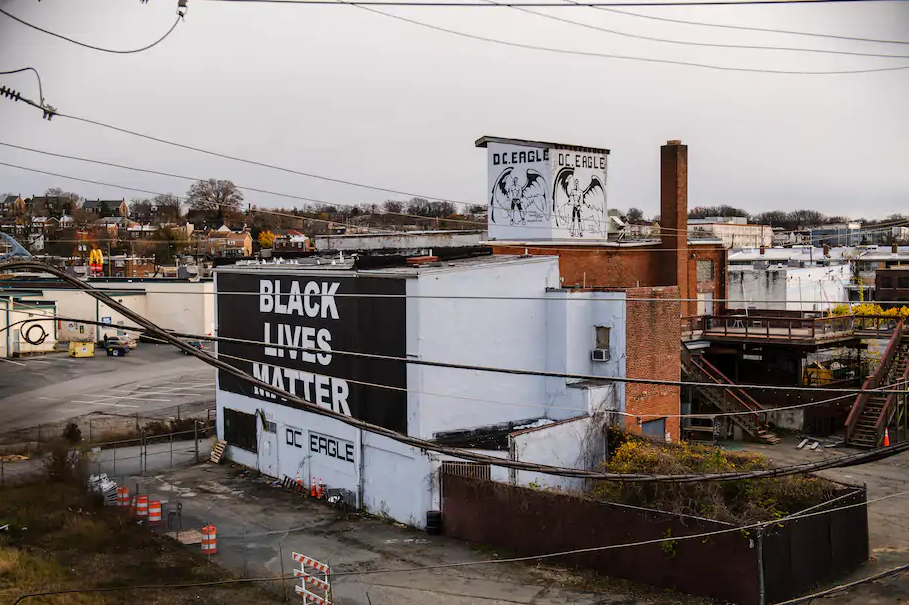Residents of a Northeast Washington neighborhood are proposing that a vacant former slaughterhouse be designated historic in a bid that could prevent a planned halfway house from opening.
Staff members of the District’s Historic Preservation Review Office said in a report they opposed an application for historic status ahead of a planned Thursday hearing because of the building’s poor condition, calling it a “remnant of a remnant.” The historic-designation feud is the latest delay amid a company’s two-year battle to open a halfway house in D.C. despite neighborhood opposition.
Core DC, a federal contractor, is seeking to open what would be the city’s only facility for men returning from prison — one that advocates say is sorely needed.
In 2018, the company bested Hope Village halfway house — a 40-year-old Southeast Washington institution that generations of D.C. offenders passed through after prison — for a five-year, $60 million contract to house 300 men.
Hope Village, which critics had long said offered substandard care, fought a months-long legal battle to win back the contract, but it folded in April in the early weeks of the coronavirus pandemic, ceding the field to Core.
After losing a lease for a vacant property in Ward 5 near the National Arboretum amid public outcry, Core purchased a structure in Ward 7, at 3701 Benning Road NE. Neighborhood opposition followed the contractor to its latest proposed location.
The Benning Road property, set off railroad tracks behind a Minnesota Avenue strip mall, is a former home of the D.C. Eagle — which the Washington Blade says is the city’s longest-operating gay bar, operated out of different locations from 1971 until its closure this year. Last month, the Eagle’s trademark and social media accounts were auctioned for more than $32,000 in a bankruptcy proceeding. (The auctioneer said this week he can’t reveal the buyer.)
But a National Register of Historic Places application, filed Sept. 25 by an advisory neighborhood commissioner who represents the area, focuses on another incarnation of the building. It states the Benning Road property was constructed about 1915 for the A. Loeffler Provisions Co. and is “the last remnant of the once vibrant industrial meat packing complex” that produced up to 75 percent of the meat produced and packaged in the nation’s capital.
Between 1924 and 1928, the application says, the complex annually processed up to 190,000 hogs and 20,000 cattle. The building closed in 1933 for improvements, according to the application, before sustaining damage in a fire and permanently closing as Congress sought to eliminate slaughterhouses in the District. The building was sold in 1941.
The application says the “abattoir provided jobs to the men and women living in the adjacent working-class neighborhoods of Northeast Washington” and is “the tangible record of these activities and their importance to our city’s past.”
“For Washington’s historical record to be complete, historians must embrace the city’s unpleasant offal — like the city’s nuisance industries — and incorporate it into the rich neighborhood histories being written for academic and popular consideration,” the application said. “This building stands alone to convey a record of this forgotten chapter of Washington’s history.”
Tyrell M. Holcomb, the advisory neighborhood commissioner who filed the application, said bestowing the historical designation on the building would honor the neighborhood’s past. The Advisory Neighborhood Commission has approved a plan to “save the property,” according to the minutes of an August meeting, and a petition to block the halfway house has garnered more than 3,600 signatures.
“DC’s meat packing industry was destroyed by an overt act of federal intervention without concern for the local citizenry,” he wrote in a message to The Washington Post. “This building not only represents our history, but also the eroding industrial heritage of the District as a whole. We want to preserve it.”
Holcomb wrote that equity in the city means halfway house services should be distributed across multiple wards, but added: “This is not about the halfway house, this is about historic preservation in our community.”
A Historic Preservation Review Office staff report issued ahead of a Thursday hearing on the building said it was of “middling importance” and a “tertiary feature” of the meat-processing complex. A staff report recommends against granting historical status, but the board is expected to make its decision during Thursday’s meeting.
“With a building as plain as this one, the character and integrity of the remaining elements becomes even more important,” the report said. “The building is a remnant of a remnant, and not a compelling candidate for designation under the local and National Register criteria for architecture as a strong example of building type.”
With the building’s future in limbo, the question of where D.C. men returning from prison should be housed remains unanswered.
Some D.C. prisoners returning to the community are housed at facilities in Maryland, Virginia and elsewhere, which advocates say makes it difficult for them to rebuild their lives in the District. The Core facility, which was supposed to open Oct. 1, would bring them back to the city — on a stretch of Benning Road set for redevelopment that could include a streetcar.
The Bureau of Prisons, which awarded the contract for the halfway house, did not respond to requests for comment. Core DC declined to comment. A spokeswoman for the D.C. Department of Corrections also declined to comment, saying that city government is not involved in the situation.
In a September meeting with the ANC, Jon Gustin, administrator for the Bureau of Prisons’ residential reentry management branch, said “numerous studies . . . show having these type of facilities in communities is very positive for the community.”
In a statement, Emily Tatro, deputy director of the Council for Court Excellence, a nonprofit that advocates for improvements to the city’s criminal justice system, said the application for historical designation “has nothing to do with historic preservation and everything do to with the preservation of economic development.”
“A position seeking to limit use of this site is taken to the detriment of the mostly Black men returning home to D.C. from prison, who have not had a halfway house to live in since April,” she wrote in an email. “We know that when people have time and stability at a halfway house to reconnect with loved ones, find work and housing, and engage in treatment, they are more likely to be successful.”
Ron Moten, a former prisoner and proponent of the Core DC facility since it was set to go to Ward 5, said those trying to derail plans for the halfway house were “hypocrites.”
The building — located near the Minnesota Avenue Metro station as well as the D.C. Department of Employment Services, a grocery store and other amenities — is ideal for people returning from prison, Moten said.
He said the situation is urgent because without a hometown halfway house D.C. inmates are sent to other jurisdictions or held in prisons as the coronavirus sweeps through them.
“How do you call an old slaughterhouse a historic landmark?” he said. “I’m tired of Black people going around, putting their fists in the air, saying ‘Black Lives Matter’ until it’s time for them to matter in their neighborhood.”




Comments are closed